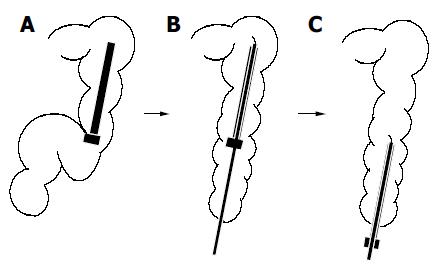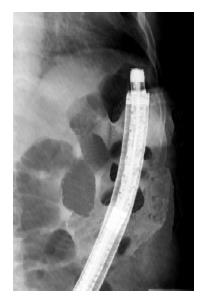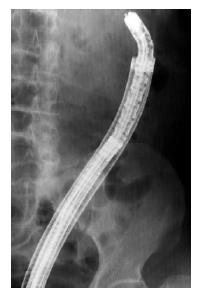Published online Sep 14, 2005. doi: 10.3748/wjg.v11.i34.5390
Revised: March 20, 2005
Accepted: March 23, 2005
Published online: September 14, 2005
We experienced a very rare complication of colonoscopy, a migration of stiffening tube into the colorectum. We herein introduce a withdrawing method of migrating stiffening tube incidentally inserted into the colorectum. A 65-year-old Japanese woman underwent colonoscopy because of abdominal discomfort. We used stiffening tube to insert the scope to the proximal colon because of her redundant sigmoid colon. When withdrawing the scope, we realized that the tube was fully inside the colorectum. We could not remove the tube instantly, and it reached the splenic flexure, finally. We reinserted the scope through the migrating tube, straightened the scope, and withdrew it holding a slight angle of the scope over the proximal end of the tube. Then, we could safely remove the tube along with the scope through the anus.
- Citation: Fukuda S, Mikami T, Shimoyama T, Hanabata N, Iwamura H, Munakata A. Withdrawing method of the stiffening tube incidentally inserted into the descending colon. World J Gastroenterol 2005; 11(34): 5390-5391
- URL: https://www.wjgnet.com/1007-9327/full/v11/i34/5390.htm
- DOI: https://dx.doi.org/10.3748/wjg.v11.i34.5390
Colonoscopy is now performed as a screening exam or as a diagnosing procedure, when the patient has some clinical manifestations of colorectal diseases. Stiffening tube is a useful device sometimes used to facilitate the insertion of colonoscope into the proximal colon[1]. We experienced a very rare untoward event that stiffening tube was fully inserted incidentally into the descending colon, and then drawn out successfully through the anus. We herein introduce the safe and easy withdrawing method.
A 65-year-old Japanese woman visited our hospital because of abdominal discomfort. We performed colonoscopy (using the scope: Olympus PCF 240I) with the aid of fluoroscopy. Her sigmoid colon was very long and redundant and made a loop when inserting the scope into the descending colon. We removed the loop after reaching the splenic flexure, and then inserted the stiffening tube (Olympus ST-C6S; about 30 cm in length) over the scope gently. However, it was very difficult to advance the scope into the cecum, because her transverse colon was also long and ptotic.
When withdrawing the colonoscope from transverse colon to descending colon, we realized that the stiffening tube was fully inside the colorectum. The distal end of the tube was inside the rectum, so we removed the scope and firstly tried to grasp the tube by our digits through the anus, but failed. W then inserted the scope again and attempted to grasp by biopsy forceps or grasping forceps, but the stiffening tube migrated gradually into the splenic flexure finally (Figure 1A). We therefore reinserted another stiffening tube along with the scope and tried to connect with the migrated tube according to the previous report[2]. However, we could not connect the two tubes smoothly.
We reinserted the scope through the migrated tube until the proximal end of the tube (Figure 2). After we assured that the scope was straight by fluoroscopy, we made a slight angle of the scope over the proximal end of the tube (Figure 1B). We withdrew the scope very slowly holding the slight angle (Figure 3), and the stiffening tube was successfully removed together from the anus (Figure 1C). There were no mucosal damages after this procedure. She went home without abdominal pain or hematochezia after about 1-h rest.
Endoscopic examination has now been routinely performed for colorectal diseases or screening. The stiffening tube is an instrument to maintain the sigmoid colon straight, when endoscopists insert the scope into the proximal colon[1]. Colonoscopes have improved in design, and there are many scopes available including the variable stiffness colonoscope[3]. Although the stiffening tube is not necessary when using the variable stiffness scope, they have not spread yet all over the world.
We sometimes used stiffening tube when we have to use other scopes, especially for the patients who are thought to have long and redundant sigmoid colon. Some complications may arise by the insertion of the stiffening tube, for example, bleeding or perforation[4]. We experienced a very rare complication, migration of the stiffening tube into the colorectum. There was only one report of the migration of the tube so far[2]. They successfully drew it through the anus using a balloon-attached endoscope and another stiffening tube. We tried their method, but could not connect two tubes straight. There was also a risk that colonic mucosa was involved between two tubes by this method.
Anyway, straightening is necessary between descending colon and rectum when withdrawing the migrated stiffening tube. So we reinserted the colonoscope through the migrated tube, straightened the scope, and attempted to withdraw the migrated tube together with scope making a slight angle. It is necessary to make sure that there are no mucosal damages, after withdrawing the scope and stiffening tube.
When the stiffening tube was fully inserted into the colorectum, we recommended our method at first, before withdrawing the scope only and leaving the tube inside the colorectum.
Needless to say, it is most important that the distal edge of the tube is always grasped during colonoscopy to prevent complications like this.
Science Editor Guo SY Language Editor Elsevier HK
| 1. | Deyhle P. A plastic tube for the maintenance of the straight-ening of the sigmoid colon during colonoscopy. Endoscopy. 1972;4:224-226. [DOI] [Full Text] |
| 2. | Nakagawa T, Kodama T, Watanabe Y, Suzuki M, Nakaya S, Inaba H, Yoneshima M, Kitajima S, Saito N, Akaishi O. The endoscopic method of drawing out a sliding tube which slipped into the descending colon: A case report. Gastroenterol Endosc. 2000;42:1864-1867. |
| 3. | Brooker JC, Saunders BP, Shah SG, Williams CB. A new variable stiffness colonoscope makes colonoscopy easier: a randomised controlled trial. Gut. 2000;46:801-805. [RCA] [PubMed] [DOI] [Full Text] [Cited by in Crossref: 80] [Cited by in RCA: 73] [Article Influence: 2.9] [Reference Citation Analysis (0)] |











